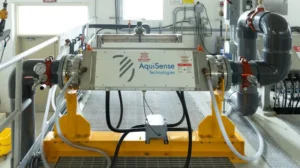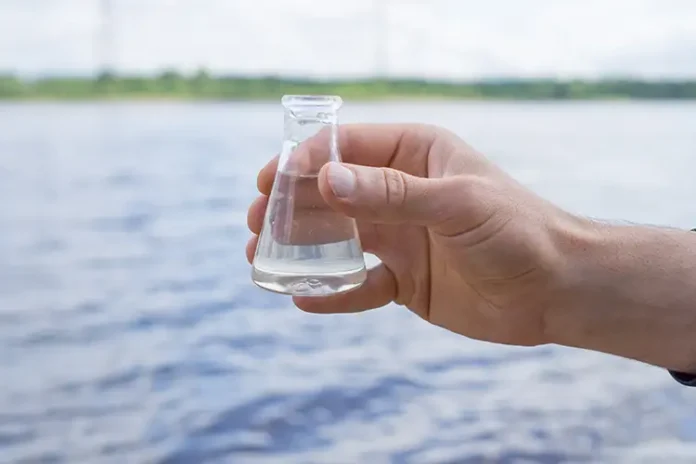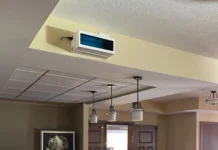IUVA One Water
Castine A. Bernardy, Ph.D. CDM Smith
James P. Malley Jr., Ph.D., Editor-in-Chief, UV Solutions,
University of New Hampshire

In a snapshot of the UV technology global market, The Business Research Company reports that the UV light disinfection market is projected to continue its strong growth, reaching $6.66 billion in 2028 at a compound annual growth rate (CAGR) of 10.3%. The UV light disinfection market has experienced robust growth in recent years, expanding from $4.10 billion in 2023 to $4.50 billion in 2024 at a CAGR of 9.8%. In the “One Water” space, the 2024 market is estimated at $1.10 billion with a CAGR of 2.5%. The overall growth in the historic period for UV light disinfection can be attributed to increased demand for portable UV sanitizers and increased utilization in HVAC systems. The growth in this forecast period also is due to a growing awareness of waterborne diseases, a focus on safe food and beverage processing, a rise of healthcare-associated infections, a growing demand for safe and sustainable disinfection solutions, and a rising need for enhanced air and water quality. More information: https://www.thebusinessresearchcompany.com/report/uv-light-disinfection-global-market-report.
One Water-Related Presentations at WEFTEC
WEFTEC 2024 will take place October 5-9, 2024, in New Orleans, Louisiana. The conference program indicates several important talks dedicated to UV, including one session entitled, “What’s New in UV?,” featuring the following presentations:
- Machine Learning in The Dark: Disinfection With <55% UV Transmittance by Jimmy Howell, Metro Water Services
- Full-Scale Comparison Between 280 nm UV LEDs and Conventional 254 nm Low-Pressure Disinfection by Sean MacIsaac, Dalhousie University
- Bye-Bye, Railcars! Nashville’s 350 MGD UV Disinfection Facility is Online by Anthony Pimental, Black & Veatch
Other UV-related presentations at WEFTEC include:
- Realization of a Digital Twin of an Operating 2.200 m³/h O3/H2O2 and UV/H2O2 Advanced Surface Water Treatment Plant by Steffen Rueting, Xylem Services
- Online UVT, Reagent-Free Disinfection Solutions by Ryan Flood, Water Analytics
One Water-Related Presentations at AWWA-WQTC
AWWA-WQTC, recognized as one of the top conferences for technical presentations by One Water professionals, will take place November 17-21, 2024, in Schaumburg, Illinois. The conference program indicates several important talks dedicated to UV, including two dedicated sessions.
TUE09: Evolution in UV Technologies
Moderated by Christine Cotton, Arcadis, and featuring the following:
- Balancing Rewards and Risks with Low Wavelength UV Applications in Water Treatment by Karl Linden, University of Colorado Boulder
- UV LEDs vs. Mercury UV for Reuse Disinfection and 1,4-Dioxane Destruction by Tara Randall, HDR
- Are UV LED Reactors Ready to Replace Conventional UV Reactors? Performance Comparisons with Bioassay Data by Brian Petri, Trojan Technologies Group ULC
WED03: UV Efficiency Impacts on Microbial Community
Moderated by Sandhya Parshionikar and featuring the following papers:
- Development of Bacteria Log-reduction Credit Tables Indicate Higher Required CT Values Compared to Virus and Protozoa by Alex Mofidi, Confluence Engineering Group LLC
- Assessing Viability of Nontuberculous Mycobacteria Following UV Treatment of Drinking Water by Monitoring Precursor-Ribosomal RNA by Nuha Alfahham, University of Michigan
- Impact of Low-Dose UV Treatment on Microbial Communities in a Full-Scale Drinking Water Distribution System by Sarah Potgieter, University of Michigan
Other UV papers and posters being presented at WQTC include:
- Evaluation of Fluence in a Flow-Through UV-LED Tubular Reactor with UV-Reflecting Material Using Actinometry by Yoontaek Oh, Pegasus Technical Services, Inc.
- Disinfection By-Product Formation and Treatment of Pre-Cursor Material in Natural Water Matrices by UV LED/Chlorine by Isobel Demont, PhD Student, Dalhousie University
- Effluent Organic Matter Transformation Following UV Irradiation at 222 nm Emission from KrCl* Excimer Lamps by Blair Hanson, Corona Environmental Consulting, LLC.
- Inactivation of Biofilm-Bound Opportunistic Pathogens in Water Supply Systems with UV-C LEDs by Madison Ferrebee, University of Colorado Boulder
- Evaluation of KrCl* 222 nm Irradiation for the Reductive Defluorination of Per-and Polyfluoroalkyl Substances by Garrett McKay, Texas A&M University
- Latest in UV Technology Research for “One Water” Applications
The Water Research Foundation (WRF) – UV LEDs
Over the past two years, WRF has funded several interesting, timely and exciting projects related to UV LED that now are making good progress. A special thanks to Dr. H. Grace Jang, research program manager at WRF, for highlighting two of these projects.
WRF 5213, Inactivation of Biofilm-Bound Opportunistic Pathogens in Premise Plumbing Using UVC LEDs, began in December 2022 under the direction of Dr. Karl Linden at the University of Colorado Boulder. The team constructed two customized UV systems, a UV LED matrix and a flow-through UV LED reactor to evaluate the performance and long-term impacts of UV-based biofilm control strategies. This is one of the first studies demonstrating the efficacy of UV treatment on biofilm formation inhibition in an experimental setup simulating water supply systems. Currently, the team is assessing the impacts of varying UV fluences, wavelengths and surface materials, which will offer valuable insights, guiding improvements in engineering designs to delay or potentially eliminate the biofilm formation in future water supply systems. More information: https://www.waterrf.org/research/projects/inactivation-biofilm-bound-opportunistic-pathogens-premise-plumbing-using-uvc.
Also funded in 2022 was Project 5218, Inactivation of Amoeba-Internalized Legionella pneumophila by UV-LED and Multi-Barrier Approaches. The work began in March 2023 under the direction of Dr. Ariel Atkinson at the Southern Nevada Water Authority. This project has four specific tasks: Task 1) Conduct a literature review summarizing the state of knowledge on amoeba-internalized L. pneumophila (AI-Lp) and identify additional research gaps; Task 2) Evaluate and optimize enumeration methods for free-living (FL) Lp, AI-Lp, amoeba in both trophozoite and cyst stages, and total Lp (FL-Lp+AI-Lp); Task 3) Evaluate chemical oxidation (i.e., free chlorine, chloramines), UV technology (low-pressure UV, UV LED), and multi-barrier approaches for inactivation of FL-Lp and AI-Lp; Task 4) Summarize findings of previous tasks and provide guidance to utilities and other stakeholders. A review of the literature focusing on disinfection methods and efficacy against Lp and AI-Lp is underway. Experimental work has examined internalization rates for different L. pneumophila strains with varying incubation temperatures and multiplicities of infection. Experiments will be conducted to assess the inactivation of FL- and AI-Lp using conventional (chlorine, chloramine, low-pressure UV), innovative (UV LED) and multibarrier approaches. More information: https://www.waterrf.org/research/projects/inactivation-amoeba-internalized-legionella-pneumophila-uv-led-and-multi-barrier.
Exciting Publication in Water Research X Volume 24
Sean A. MacIsaac, Bailey Reid, Carolina Ontiveros, Karl G. Linden, Amina K. Stoddart and Graham A. Gagnon published work entitled, “UV LED wastewater disinfection: The future is upon us.” The paper reported a >3-log log reduction of total coliform at 545 m3 day−1 and the 817 m3 day−1 flow rate achieved over a > 2.5 average log reduction for all operational conditions. The paper’s results demonstrated the performance that can be achieved by UV LED disinfection, and it also demonstrated that bench-scale disinfection results could be related to full-scale performance. That study demonstrated that UV LEDs are an effective wastewater disinfectant at-scale, are comparable to conventional low-pressure UV systems and provided an approach that utilities can use to select, design and implement UV LED systems for wastewater disinfection.






